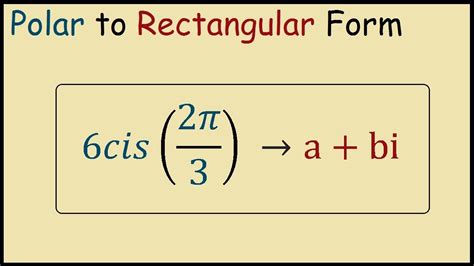Complex numbers have numerous applications in mathematics, physics, and engineering. They can be represented in two primary forms: rectangular and polar. While both forms are essential in understanding complex numbers, they have distinct advantages and uses. In this article, we will delve into the world of rectangular and polar forms, exploring their definitions, conversions, and applications.
Understanding Rectangular Form
The rectangular form, also known as the Cartesian form, represents a complex number as a sum of real and imaginary components. It is expressed as z = a + bi, where 'a' is the real part, 'b' is the imaginary part, and 'i' is the imaginary unit, satisfying i^2 = -1. The rectangular form is useful for algebraic manipulations and is the foundation for many mathematical operations involving complex numbers.

For instance, consider the complex number z = 3 + 4i. Here, the real part 'a' is 3, and the imaginary part 'b' is 4. This form is essential for performing operations like addition, subtraction, multiplication, and division.
Understanding Polar Form
The polar form, also known as the trigonometric form, represents a complex number in terms of its magnitude and angle. It is expressed as z = r(cosθ + isinθ), where 'r' is the magnitude (or modulus) and 'θ' is the argument (or angle). The polar form is convenient for visualizing complex numbers and performing operations that involve rotation and scaling.

Using the same example, z = 3 + 4i, we can express it in polar form as z = 5(cosθ + isinθ), where the magnitude 'r' is √(3^2 + 4^2) = 5, and the angle 'θ' is arctan(4/3).
Conversion Between Rectangular and Polar Forms
Converting between rectangular and polar forms is essential for solving complex number problems. To convert from rectangular to polar form, we use the following formulas:
r = √(a^2 + b^2) θ = arctan(b/a)
Conversely, to convert from polar to rectangular form, we use:
a = rcosθ b = rsinθ

These conversions are crucial for solving problems involving complex numbers, as they allow us to switch between the two forms to take advantage of their respective strengths.
Applications of Rectangular and Polar Forms
Both rectangular and polar forms have numerous applications in mathematics, physics, and engineering.
Rectangular form is used extensively in:
- Linear algebra and matrix operations
- Signal processing and filter design
- Control systems and stability analysis
Polar form is used extensively in:
- Trigonometry and geometry
- Electromagnetism and circuit analysis
- Navigation and astronomy

In conclusion, understanding both rectangular and polar forms is essential for working with complex numbers. While rectangular form is ideal for algebraic manipulations, polar form is convenient for visualizing and performing operations involving rotation and scaling. By mastering both forms and their conversions, you will be well-equipped to tackle a wide range of problems in mathematics, physics, and engineering.
Conclusion and Final Thoughts
In this comprehensive guide, we have explored the world of rectangular and polar forms, including their definitions, conversions, and applications. We have seen how these forms can be used to represent complex numbers, perform operations, and solve problems. By understanding the strengths and weaknesses of each form, you can choose the most suitable approach for your specific needs.
Take the Next Step
Now that you have a deep understanding of rectangular and polar forms, take the next step by practicing problems and exploring real-world applications. Share your experiences and insights in the comments below, and don't hesitate to ask questions if you need further clarification.
What is the main difference between rectangular and polar forms?
+The main difference between rectangular and polar forms is the way they represent complex numbers. Rectangular form represents a complex number as a sum of real and imaginary components, while polar form represents it in terms of magnitude and angle.
How do I convert from rectangular to polar form?
+To convert from rectangular to polar form, use the formulas: r = √(a^2 + b^2) and θ = arctan(b/a).
What are the applications of polar form?
+Polar form has numerous applications in trigonometry, geometry, electromagnetism, circuit analysis, navigation, and astronomy.
